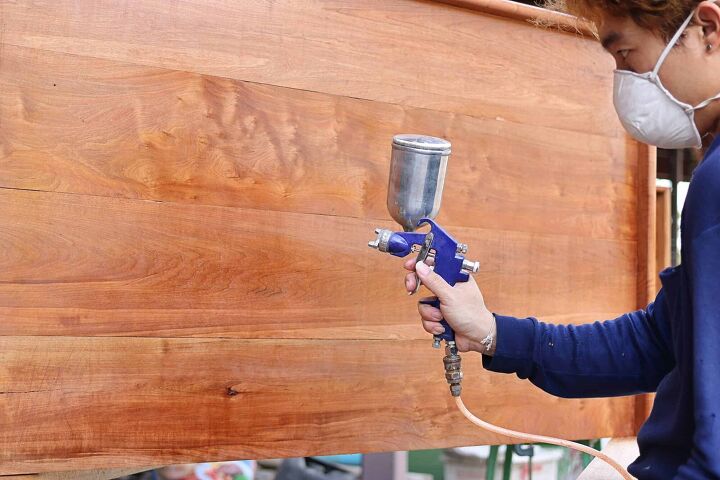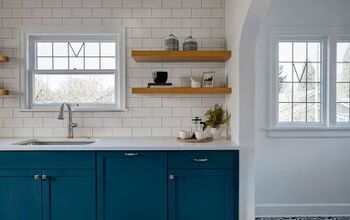Can You Spray Clear Coat Over Old Clear Coat?

When you’re excited about tackling a home project, it can be very tempting to jump in and get it done quickly. However, if you skip vital prep work, you might end up with shoddy work and wasted time.
You can spray a new clear coat over the old clear coat if it is the same type.
However, if the old clear coat is in poor shape, it is best to remove it first. Trying to apply a new clear coat over a peeling layer or damaged clear coat will ruin your project.
Clear coat is a great way to add extra durability and shine to a piece of furniture or a home accessory. It can breathe new life into an old piece. However, if the existing clear coat looks a little rough, your first step is to prep it!
Do You Need to Hire a Paint Contractor?
Get free, zero-commitment quotes from pro contractors near you.

What is Clear Coat?
Put simply, clear coat is a layer of transparent paint or resin. It is generally applied over the top of a base coat to help protect the color from oxidation and wear. However, the major benefit of applying clear coat is to achieve that noteworthy deep, glossy shine that indicates a perfect paint job.
Although clear coat is strong enough to safeguard against the elements, consistent exposure to sunlight and harsh weather conditions can result in fading and general wear of the clear coat. This is why it’s recommended to wax the paint often. While clear coat is designed to protect the base coat, wax is formulated to protect the actual clear coat.
Tips for Using Clear Coat
Clear coat comes in several types, including shellac, lacquer, and oil and water-based polyurethane and polycrylic. The latter is the easiest to apply, and you can find it in a variety of finishes.
Depending on the look you want for the finished piece, you can choose from low, medium, or high-gloss finishes. No matter what type of clear coat you decide to use, make sure to work in a well-ventilated area.
To ensure your clear coat goes on smoothly and creates a stain-resistant finish, make sure to prepare the piece first. Different finishes require different preparation.
How Do You Prepare a Piece of Bare Wood for Clear Coat?
Tools You Need for the Job
- Rag or cloth
- Sandpaper or a sander
- Steel wool
- Tack cloth
- Small brush
- Wood pore sealer (if your piece features coarse-grained wood like oak or pine)
- Dust mask/gloves
- Drop Cloth
Step One
Lightly sand the entire piece, going in line with the wood grain. On areas where you desire a very smooth look and feel, follow up with the steel wool.
Step Two
Use the tack cloth to wipe down the piece and remove all of the fine particles. Wipe down with a damp rag.
Step Three
Brush on a thin coat of the wood pore sealer to keep your piece from looking blotchy.
How Do You Prepare a Previously-Stained Item for Clear Coat?
Tools You Need for the Job
- Rag or cloth
- Mild dish soap and water
- Degreaser
- Shellac or sealer
- Small brush
- Fine-grit sandpaper or steel wool
- Dust mask, gloves
- Drop cloth
Step One
Dust the piece and wash it with soap and water. Use a degreaser if the piece has visible grime, a glossy finish, or is waxed.
Step Two
Brush on a thin coat of sealer or shellac to keep the surface even.
How Do You Prepare a Painted Piece for Clear Coat?
Tools You Need for the Job
- Rag or cloth
- Shellac or sealer
- Small brush
- Fine-grit sandpaper or steel wool
- Dust mask/gloves
- Drop cloth
Step One
Dust the piece and make sure it is clean.
Step Two
Depending on the piece’s existing finish, you may need to sand it lightly to improve adhesion.
Step Three
If the piece has a high-gloss finish, apply a thin layer of shellac or sealer to help with adhesion.
Note: No matter what piece you are working on, don’t open your clear coat until right before you are ready to use it. Gently stir it with a paint stick to get rid of bubbles. Never shake your can of poly; this creates bubbles that show up in the finish!
You will need to apply two to three coats of poly-coat to your piece for the best results. Make sure each layer is completely dry before applying the next one.
If you live in a very humid area, it might take as long as 24-hours for one coat to dry. Lightly sand the piece and wipe down with a damp rag or piece of tack cloth between each coat.
How Do You Remove Old Clear Coat?
If the existing clear coat is chipping, peeling, or damaged, it is best to remove it altogether. The trick is, you want to remove the clear coat without removing the paint or damaging the wood beneath it.
You can use several products to vanquish old clear coat and varnish:
- Sandpaper
- Solvents
- Strippers
Sandpaper — You can use light sandpaper to remove the topcoat. If you plan to paint the piece before applying a new layer of clear coat, sanding is all you need.
Solvents — If the existing clear coat is shellac or lacquer, you need to use a solvent like denatured alcohol. You can also use a lacquer thinner if the denatured alcohol does not work. Simply apply the solution with a rag and then scrape away the finish with a dull putty knife.
Strippers — Chemical strippers work very well at removing varnish, but they can cause significant irritation to you and the environment. Water-based strippers contain fewer irritants, but make sure to work in a well-ventilated area.
Apply the stripper according to the manufacturer’s directions, then wipe away with a piece of steel wool.
What Is the Best Way To Apply Clear Coat?
Spray clear coats, sold in aerosol cans, have become popular in recent years. It is easy to use and provides a beautiful finish to a variety of different materials.
Typically, you apply clear coat with a brush. However, several newer varieties are wipe-on formulas. You can wipe these on with a rag or soft, lint-free cloth.
Make sure to apply the clear coat in whichever way it is designed and follow the labeling instructions.
Wipe-on and spray clear coats are good options for pieces with a lot of nooks and crannies. You won’t have to worry as much about drip marks and build-up in these crevices.
Can You Paint Over Clear Coat on a Car?
Before you consider painting over clear coat on your vehicle, you must sand off a layer of clear coat. Therefore, you cannot simply paint directly over clear coat in these instances. However, this does only apply if the body panel is in relatively good condition. If there are marring, oxidation, flaking, or deep scratches, the best course of action is to sand off all of the clear coat to get rid of the damage.
Preparing the surface is key to a successful paint job, whether you’re painting a car or a piece of furniture. If you were to just spray a coat of base paint over the clear coat, the paint will not be able to properly adhere to the surface, resulting in an undesirable finish.
For example, if you want to paint the fenders on your car and they are mostly free of any large defects, all you need to do is lightly sand to prepare the surface for painting. The goal is to remove a significant layer of the clear coat. After you’ve completed sanding, you can safely start to apply your layers of color.
Related Questions
Which is better, water-based or oil-based polyurethane?
It depends. Both of these products have advantages and disadvantages. Oil-based topcoats will typically take fewer coats and are easy to apply, but usually take longer to dry.Water-based topcoats can be a bit more temperamental. They take more coats. However, they dry more quickly and show fewer brush marks. Also, oil-based clear coats tend to give a yellowish, or amber-hue to pieces. Water-based top coats are usually clearer with a more natural appearance. Therefore, consider how you want your finished piece to look before you choose your topcoat.
Do you have to use a clear coat to finish furniture?
It isn’t necessary to use a clear coat on all pieces. Depending on how your piece is currently finished, it may already be very durable. However, for pieces that see a lot of use, a clear coat can add extra resistance and life to it.
Do You Need to Hire a Paint Contractor?
Get free, zero-commitment quotes from pro contractors near you.

Wrapping Up
Basically, you can apply a new clear coat to an old clear coat, but it depends on a few things. Unless the existing clear coat is exactly the same as the one you want to apply, you should first prepare your piece.
If the existing clear coat is peeling or damaged, it is best to remove it before applying the new topcoat. Once your piece is prepped properly, you can apply your new clear coat with confidence!
You’ll have a durable, beautiful piece of furniture that will last for years!

Stacy Randall is a wife, mother, and freelance writer from NOLA that has always had a love for DIY projects, home organization, and making spaces beautiful. Together with her husband, she has been spending the last several years lovingly renovating her grandparent's former home, making it their own and learning a lot about life along the way.
More by Stacy Randall












![The 5 Best Angle Grinders – [2022 Reviews & Buyer's Guide]](https://cdn-fastly.upgradedhome.com/media/2023/07/31/9071326/the-5-best-angle-grinders-2022-reviews-buyer-s-guide.jpg?size=350x220)














